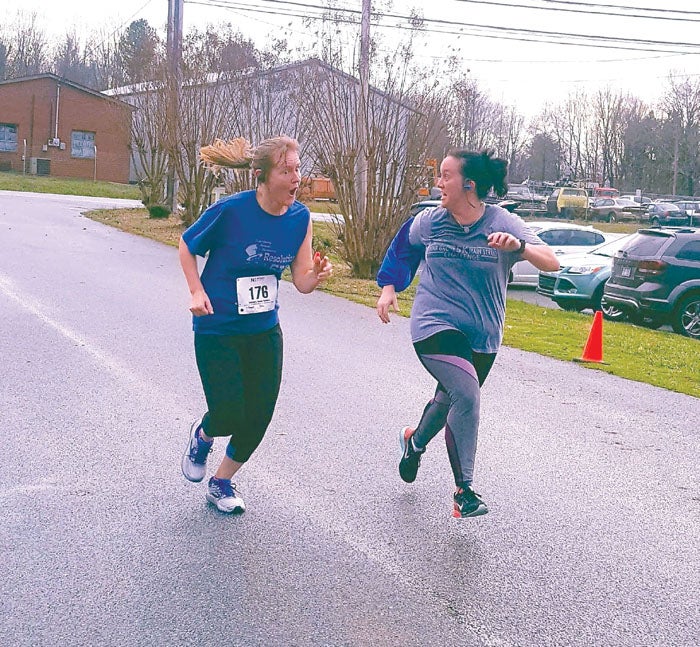David Freeze: Gotta Run
Published 12:00 am Sunday, January 6, 2019

- Julie Stegall (L) and Jennifer McBride have a thrilling race to the finish at the Resolution Run 5K on January 1st. Lots of runners did their first 5K. Photo by Brooke Taylor.
Doing something different
Yes, it is time for resolutions. Just like others, I have had some success but some failure too. Many runners get into a rut this time of year and need a little boost. Some days you just want to run easy, while other days it may seem impossible to hold yourself back. Slower and faster running both have their places in every runner’s training plan but knowing how and why to implement each type is essential to your success.
Our muscle fibers play an essential role in our ability to sprint and also run long and easy. Developing both types of skills is beneficial, whether you’re training to run a fast mile or an ultramarathon. Different types of workouts can be used to target each group of muscle fibers.
We are all born with slow- and fast-twitch muscle fibers. On average, we start with about 50 percent of each, but we can improve their function and efficiency with training. The slow-twitch fibers are primarily responsible for longer, sustained efforts of endurance-based training. They fire less forcefully than fast-twitch fibers but also require less energy.
Fast-twitch fibers are responsible for explosive movements like sprinting. They can only be used for short periods of time as they are larger and less efficient.
The muscle fibers that you’re born with play an important role in your development as a runner but they’re responsible for less than half of your performance! Your long-term training affects how you refine and improve the fibers you start with, along with other non-physiological factors like mental drive and competitiveness.
No matter what you’re training for, it’s most effective to include workouts that target each kind of muscle fiber. Incorporating speed sessions into your endurance training allows you to increase muscular coordination, making you more fluid and efficient at any pace. Speed work specifically targets your fast-twitch fibers, so your stride becomes more explosive with less effort.
These workouts target specific types of fibers:
• Long runs: slow twitch
• Tempo runs: both slow and fast
• Short or interval repeats: fast twitch
• Strides and hill sprints: fast twitch
As a general rule, it’s ideal to run about 75-80 percent of your mileage at an easier effort and 20-25 percent of your time on faster sessions. This will vary to some degree depending on your age, what you’re training for, as well as what phase of training you’re in.
What you don’t want to do is spend all your time training in a middle zone, somewhere in between fast and slow, which isn’t hard enough to stimulate improvement but not easy enough to allow for recovery. Keep your hard days hard and your easy days easy!
Both easy days and speed sessions are critical to your running success. When scheduling challenging runs, don’t try to cram in too much and definitely allow for recovery time in between. Hard workouts should almost always be in the middle of two easy days, while some workouts may require several recovery days. So if a big 5K race is scheduled for Saturday, do your hard speed session on Wednesday.
Easy running can be done by feel, tracking heart rate or monitoring pace. If you’re watching your pace, know that weather conditions and fatigue (among other factors) can significantly impact how easy a run really feels. Without these recovery runs, your body won’t have time to process harder workouts, and you won’t gain as much from them.
Some types of speed work can be done on your easier days, including strides and hill sprints and can be done more frequently than longer track sessions and tempo runs.
While it’s fun to get out there and push yourself, make sure you strike a balance with slower, easier miles. You’ll get the most out of your running when you incorporate a variety of workouts into your training plan.
Some say, “I’ve been running the same miles for so many weeks and I never get faster.” My favorite saying to those who want to gain speed, “To run fast, you’ve got to run fast!” (In training, so see above).
Something I have been doing has added a little extra fun. After 5-6 miles of moderate running, I rest for 3-4 minutes. Then, I run as hard as possible for a half a mile. Those times have been improving, so I’ll keep it up.
Check www.salisburyrowanrunners.org for the 2019 Novant Health Winter Flight 8K/5K and other upcoming events.


